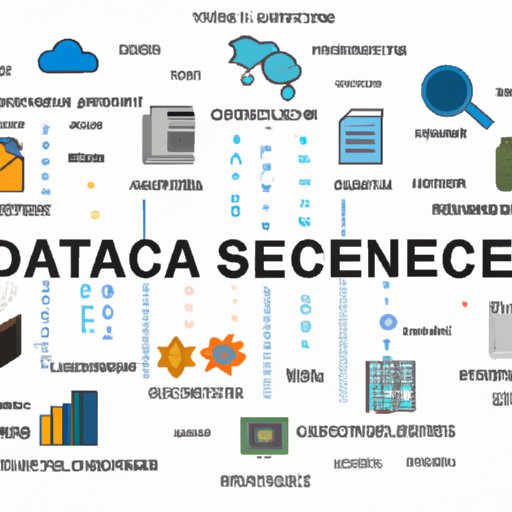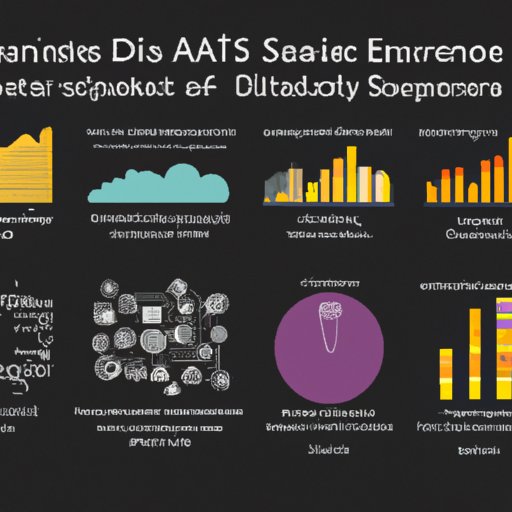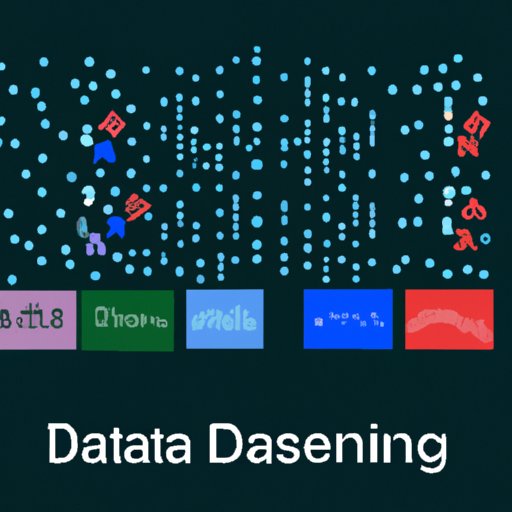Introduction
Data science is an interdisciplinary field that combines mathematics, statistics, computer science, and other related disciplines in order to analyze large volumes of data. It is used to gain insights into trends and patterns, identify correlations and causations, and make predictions and forecasts. In recent years, it has become an essential tool for businesses and organizations to leverage in order to gain a competitive edge.
Definition of Data Science
Data science is the process of extracting knowledge from large amounts of structured and unstructured data. This involves using advanced techniques, such as machine learning, statistical analysis, and natural language processing, to uncover new insights and draw meaningful conclusions. It also involves utilizing big data analytics tools to store, manage, and analyze large volumes of data.

Overview of the Different Types of Data Science
Data science is composed of several different disciplines and technologies, each of which has its own unique set of benefits. These include machine learning, statistical analysis, natural language processing, and big data analytics. Each of these disciplines has its own distinct methods and techniques for extracting insights from data.
Exploring the Benefits of Data Science with Relevant Examples
Data science can be used to improve decision-making, make predictions and forecasts, and enhance business performance. Here are some examples of how data science can be applied in various industries.
How Data Science Can Improve Decision-Making
Data science can help organizations make better decisions by providing them with more accurate insights into their operations. By analyzing large volumes of data, data scientists can uncover correlations, trends, and patterns that may not be immediately apparent. This can provide organizations with valuable insight into how they should allocate resources and make decisions.
Using Data Science to Make Predictions and Forecasts
Data science can also be used to make predictions and forecasts about future events or trends. By analyzing historical data, data scientists can develop models that can be used to predict outcomes or identify potential opportunities. For example, data science can be used to predict customer behavior, market trends, and financial performance.
Enhancing Business Performance With Data Science
Data science can also be used to improve business performance. By analyzing customer data, companies can identify areas where they can optimize their processes and increase efficiency. Additionally, data science can be used to develop new products and services, as well as to personalize customer experiences.
A Beginner’s Guide to Data Science: Definition and Examples
For those just getting started in data science, it can be helpful to have a basic understanding of the different types of data science and the skills required to be successful. Here is a beginner’s guide to data science.
What is Data Science?
Data science is the process of extracting knowledge from large amounts of structured and unstructured data. It involves using advanced techniques, such as machine learning, statistical analysis, and natural language processing, to uncover new insights and draw meaningful conclusions. It also involves utilizing big data analytics tools to store, manage, and analyze large volumes of data.
What Skills Does a Data Scientist Need?
In order to be successful in data science, data scientists need to have strong analytical and problem-solving skills. They must also be proficient in programming languages such as Python and R, as well as be familiar with databases, machine learning algorithms, and big data tools. Additionally, data scientists must be able to communicate their findings effectively and present them in a way that is easy to understand.
Examples of Data Science Projects
Data science projects can range from analyzing customer data to predicting stock prices. Some examples of data science projects include: using customer data to create personalized product recommendations; using machine learning to detect fraud; using natural language processing to analyze customer feedback; and using big data analytics to identify correlations between different variables.

Analyzing the Different Types of Data Science and Examples of Their Applications
Depending on the type of project, data scientists may use one or more of the following disciplines to analyze data and extract insights.
Machine Learning
Machine learning is a type of artificial intelligence that uses algorithms to learn from data. It can be used to identify patterns and correlations in data, as well as to make predictions and forecasts. Examples of machine learning applications include fraud detection, image recognition, and natural language processing.
Statistical Analysis
Statistical analysis is a type of data analysis that uses mathematical models to identify patterns and relationships in data. It can be used to test hypotheses and make predictions. Examples of statistical analysis applications include A/B testing, predictive analytics, and forecasting.
Natural Language Processing
Natural language processing (NLP) is a type of artificial intelligence that focuses on understanding and interpreting human language. It can be used to analyze customer feedback, detect sentiment, and generate natural language responses. Examples of NLP applications include chatbots, automated customer service systems, and text mining.
Big Data Analytics
Big data analytics is a type of data analysis that uses powerful computing tools and algorithms to process large volumes of data. It can be used to uncover trends, correlations, and patterns in data. Examples of big data analytics applications include real-time streaming analytics, predictive analytics, and social media analytics.
Examining the Power of Data Science Through Real-World Examples
Data science can be used to solve complex problems and improve decision-making across a variety of industries. Here are some examples of how data science is being used in the real world.
Automation and Robotics
Data science is being used to power automation and robotics in many industries. For example, data science can be used to build robots that can interact with their environment, such as self-driving cars. Additionally, data science can be used to automate mundane tasks, such as sorting items in warehouses.
Healthcare
Data science is also being used to improve healthcare. For example, data science can be used to create predictive models that can help doctors diagnose and treat diseases more accurately. Additionally, data science can be used to analyze patient data and provide personalized treatment plans.
Government Agencies
Data science is being used by government agencies to improve public services. For example, data science can be used to analyze crime data and provide insights into policing strategies. Additionally, data science can be used to identify potential fraud and abuse in government programs.
Financial Services
Data science is also being used by financial institutions to improve customer experience. For example, data science can be used to create personalized financial advice and recommendations. Additionally, data science can be used to detect fraud and risk in real time.
Conclusion
This article has explored the definition, benefits, and application of data science. Data science is a powerful tool that can be used to improve decision-making, make predictions and forecasts, and enhance business performance. By leveraging the power of data science, organizations can gain a competitive edge and unlock new opportunities for growth.
Summary
Data science is an interdisciplinary field that combines mathematics, statistics, computer science, and other related disciplines in order to analyze large volumes of data. It involves using advanced techniques, such as machine learning, statistical analysis, and natural language processing, to uncover new insights and draw meaningful conclusions. Data science can be used to improve decision-making, make predictions and forecasts, and enhance business performance. It is being used in a variety of industries, such as automation and robotics, healthcare, government agencies, and financial services.
Final Thoughts on the Impact of Data Science
Data science is a powerful tool that can be used to improve decision-making, make predictions and forecasts, and enhance business performance. As technology continues to evolve, so too will the power of data science to unlock new opportunities for growth.
(Note: Is this article not meeting your expectations? Do you have knowledge or insights to share? Unlock new opportunities and expand your reach by joining our authors team. Click Registration to join us and share your expertise with our readers.)
